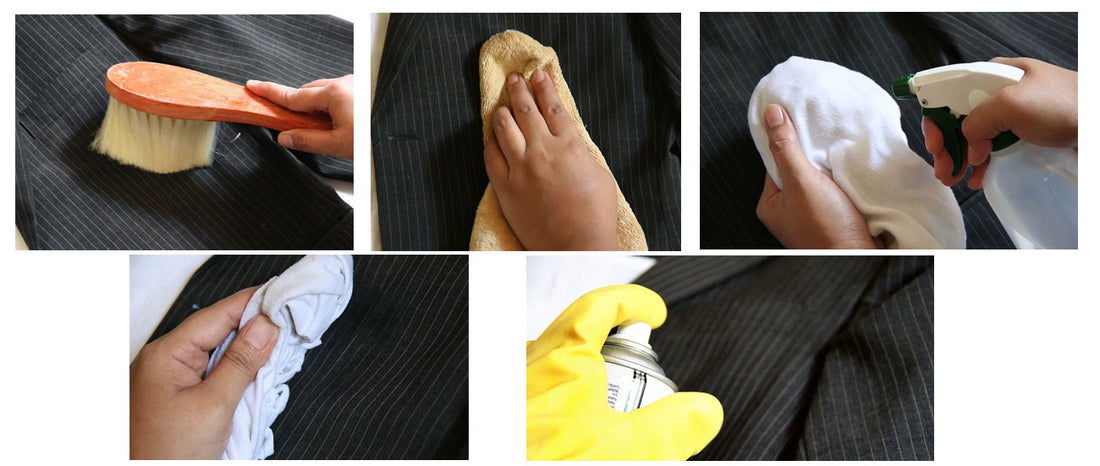No matter how hard you try to prevent it, your suit jacket will eventually become stained. Maybe it's from your morning coffee, or perhaps it's from mid-day lunch. Regardless, stains are inevitable. And when a stain develops on your suit jacket, it can greatly affect your overall appearance. So, what's the best way to treat stains on a suit jacket?

#1) Check the Care Label
Before attempting to remove or treat any stains on your suit jacket, you should first check the care label. Being that different suits are made with different fabrics and techniques, recommended cleaning methods will vary. You can find out the ideal cleaning method for your suit jacket, however, by checking the care label. Typically found inside the neck collar, this label reveals the manufacturer's recommendations on how to clean and care for the jacket.#2) Blot with Water
Unless otherwise stated on the care label, you should first treat the stain by blotting it with water. There are dozens of different stain-removing products, some of which are more effective than water. However, water is generally safe and won't cause discoloration or other damage to your jacket. Therefore, you should first attempt to clean the stain by blotting it with a clean washcloth or paper towel and water. If the stain is new and hasn't "set in" yet, this method may suffice.

#3) Use Light Pressure
When attempting to remove stains from your suit jacket, try to use as little pressure as possible. Some people assume that applying more pressure will remove the stain more easily. In reality, though, this actually makes the problem worse by causing the stain to set in. Instead of scrubbing the stain, lightly blot it. The general idea is to remove the stain by blotting it up instead of scrubbing it. The harder you scrub, the more set in the stain will become. So, apply light pressure to prevent this from happening.#4) Keep Away from Heat
Pressure isn't the only thing that causes stains to set in; heat does as well. When stains are exposed to heat -- fireplaces, warm air, etc. -- it causes them to set in. The ingredient or compound responsible for the stain bleeds into the fabric, making it more difficult to remove. Because of this, you should keep your stained jacket away from any and all heat sources until it's properly cleaned.

#5) Test Stain-Removing Products in Discreet Area
Unfortunately, water alone won't always do the trick. Depending on what specifically caused the stain on your suit jacket, you may have to use a stronger cleaning agent, such as a chemical-based stain-removing product. There are dozens of different stain-removing products available on the market, many of which are highly effective. With that said, some of these products can actually cause additional stains, which is why it's a good idea to test them in a discreet area of your jacket. If your suit jacket currently has a big stain on the front, for instance, test the stain-removing product on the interior before using it on the front. Assuming it doesn't cause any discoloration, you can then proceed to use it on the actual stain.

#6) Don't Use Hot Water on Wool Suit Jackets
Wool suit jackets are often preferred over cotton and linen during the winter. As you may already know, wool is thicker, heavier and warmer than other common fabrics in which suit jackets are made. Because of this, many guys choose wool suit jackets during the otherwise cold winter months. But if your wool jacket develops a stain, you shouldn't attempt to clean it with hot water. Wool is perhaps the least tolerant to heat. Exposure to hot water can cause severe damage to a wool jacket. Furthermore, most experts will agree that cold water is just as effective at cleaning stains as hot water.

#7) Vinegar or Lemon Juice
You really can't go wrong when using vinegar or lemon juice to remove stains on a suit jacket. Because of their acidic properties, these substances are highly effective at removing most stains. As an added benefit, the acidic properties of vinegar and lemon juice will kill germs while leaving your jacket nice and clean afterward. Just remember to choose distilled white vinegar and not vinegar with the "mother" in it. If the vinegar isn't distilled, the mother -- bacterial colonies -- may further stain your suit jacket. And when using either vinegar or lemon juice, follow the mantra "less is more." Using too much vinegar or lemon juice could damage the delicate fabric of which your jacket is made.#8) Clean Promptly
The golden rule of cleaning stains is to act fast. The longer you wait, the more difficult it will be to remove. You won't always have the option of taking off your jacket and cleaning it immediately after you discover a stain. Nonetheless, you should try to clean it as soon as possible. Regardless of which cleaning you method you prefer, time is of the essence.




